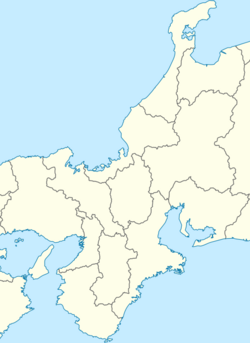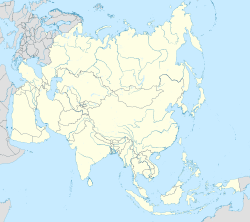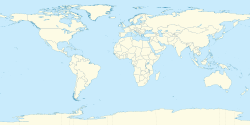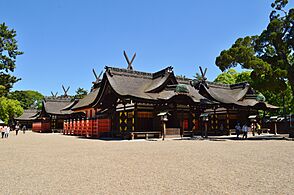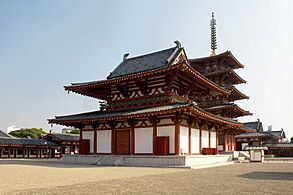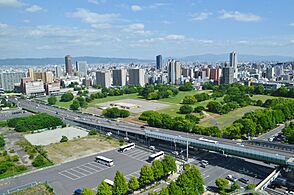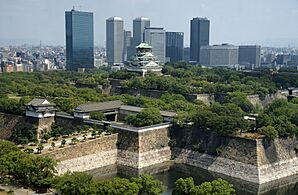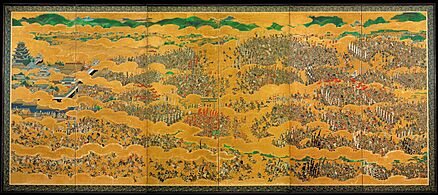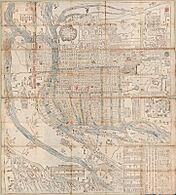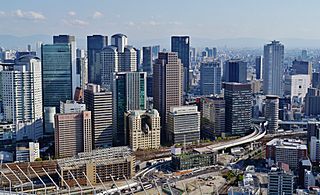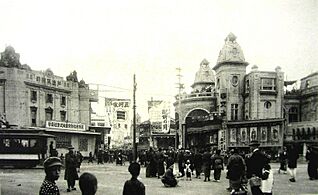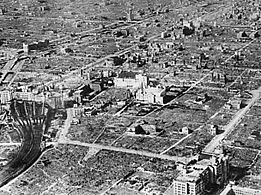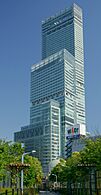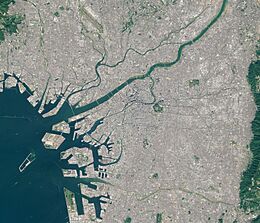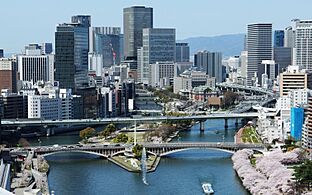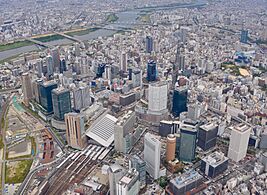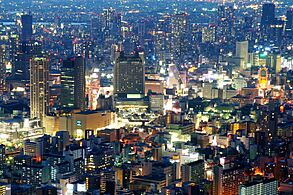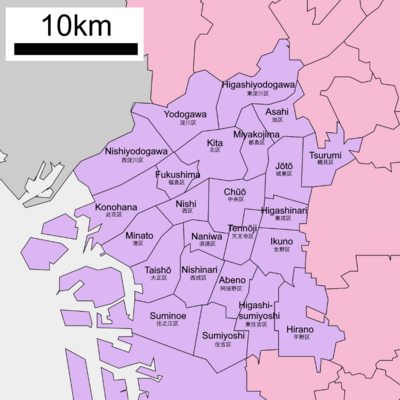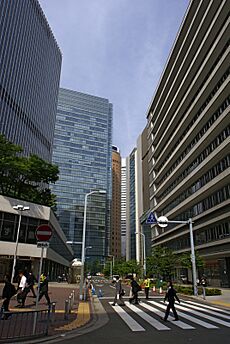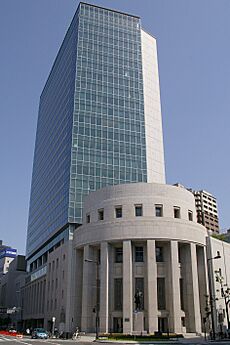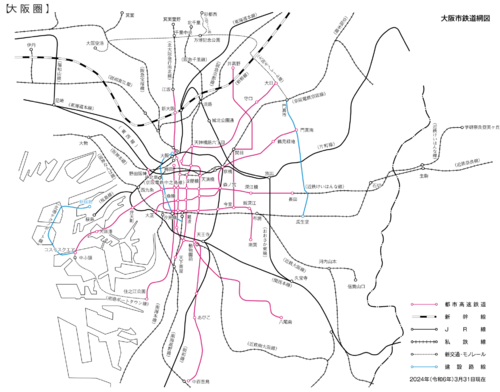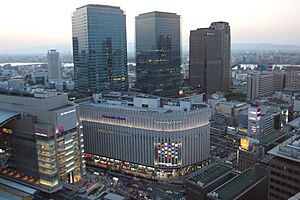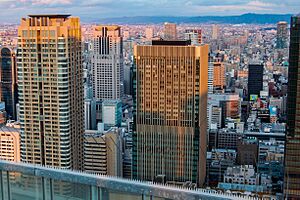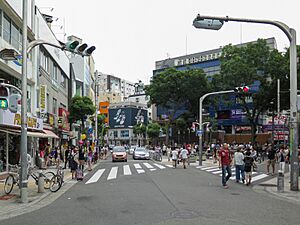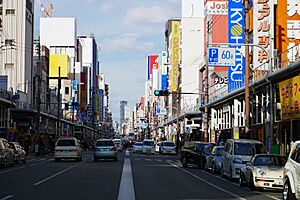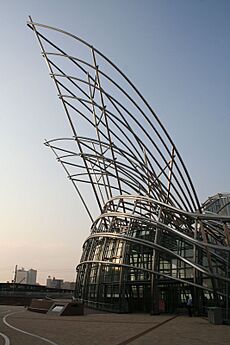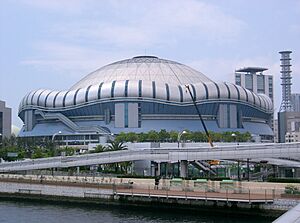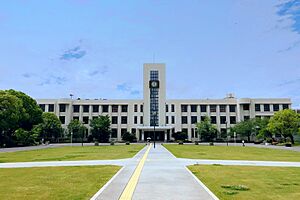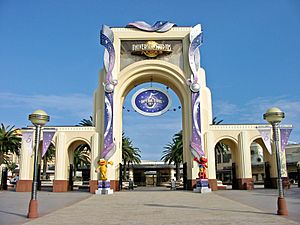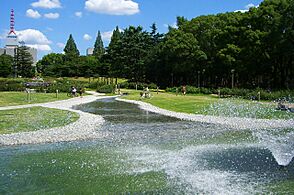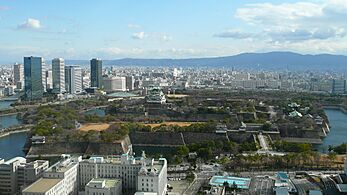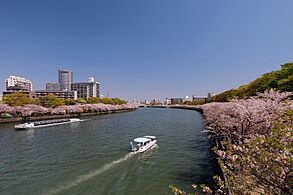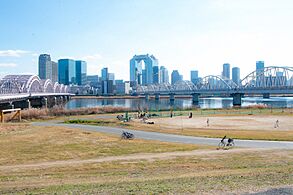Osaka facts for kids
Quick facts for kids
Osaka
大阪市
|
|||
|---|---|---|---|
| Osaka City | |||
|
From top, left to right: Osaka Castle and Osaka Business Park, Tsūtenkaku tower in Shinsekai, Dōtonbori, The Dainihongu (second sanctuary) and Sorihashi bridge of Sumiyoshi Taisha shrine, Shitennō-ji within Abeno Harukas, Midōsuji Avenue and Nakanoshima island
|
|||
|
|||
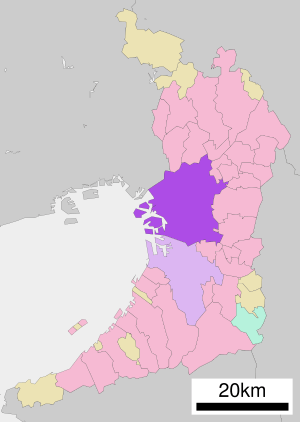
Location of Osaka in Osaka Prefecture
|
|||
| Country | Japan | ||
| Region | Kansai | ||
| Prefecture | Osaka Prefecture | ||
| Island | Honshu | ||
| Government | |||
| • Body | Osaka City Council | ||
| Area | |||
| • Designated city | 225.21 km2 (86.95 sq mi) | ||
| Population
(March 1, 2021)
|
|||
| • Designated city | 2,753,862 | ||
| • Rank | 3rd in Japan | ||
| • Density | 12,214/km2 (31,630/sq mi) | ||
| • Metro
(2nd)
|
19,303,000 (2019, Keihanshin) | ||
| Time zone | UTC+9 (Japan Standard Time) | ||
| - Tree | Cherry | ||
| - Flower | Pansy | ||
| Address | Osaka City Hall: 1-3-20 Nakanoshima, Kita-ku, Osaka-shi, Osaka-fu 530-8201 |
||
| Phone number | 06-6208-8181 | ||
| Osaka | |||||||
|---|---|---|---|---|---|---|---|

Ōsaka in kanji
|
|||||||
| Japanese name | |||||||
| Kanji |
|
||||||
|
|||||||
Osaka (Japanese: 大阪市, Hepburn: Ōsaka-shi, pronounced [oːsakaɕi]; commonly just 大阪, Ōsaka [oːsaka]) is a major city in Japan. It is located on the island of Honshu in the Kansai region. Osaka is the capital and largest city in Osaka Prefecture.
It is the third-most populated city in Japan. Only Tokyo and Yokohama have more people. In 2020, about 2.7 million people lived in Osaka. It is also part of the Keihanshin Metropolitan Area. This is the second-largest metropolitan area in Japan. It has over 19 million people.
Osaka has always been an important economic center in Japan. It was a busy port city as early as the Kofun period (300–538 AD). For a short time in the 7th and 8th centuries, it was even the capital of Japan. Osaka continued to grow during the Edo period (1603–1867). It became a famous center for Japanese culture.
After the Meiji Restoration in 1868, Osaka grew a lot. It quickly became an industrial city. By the early 1900s, it was a major industrial hub. After World War II, Osaka helped rebuild Japan. It became a big financial center in the Keihanshin Metropolitan Area.
Today, Osaka is a major financial hub in Japan. It is known as one of Japan's most diverse and global cities. Many big companies have their main offices here. These include Panasonic and Sharp. Osaka is also a center for research and development. It has several important universities.
Some famous places in Osaka are Osaka Castle, Osaka Aquarium Kaiyukan, and Dōtonbori. You can also visit Tsūtenkaku tower in Shinsekai. Other popular spots include Tennōji Park and Abeno Harukas. Don't miss the Sumiyoshi Taisha Grand Shrine and Shitennō-ji. Shitennō-ji is one of Japan's oldest Buddhist temples.
Contents
What Does the Name Osaka Mean?
The name Ōsaka means "large hill" or "large slope." We don't know exactly when this name became popular. But we know it was used in writing by 1496.
During the Edo period, people used two different ways to write Ōsaka. One way was 大坂. The other was 大阪. The first way, 坂, was thought to be unlucky. It meant "returns to the earth." So, after the Meiji Restoration in 1868, 阪 became the official way to write it. Today, the older way is rarely used.
A Brief History of Osaka
Osaka has a very long and interesting history. It has been an important place for thousands of years.
Early Settlements: Jōmon and Yayoi Periods
About 9,000 years ago, during the Jōmon period, most of Osaka was underwater. The Uemachi Plateau was a long peninsula. It was a great place for early people to live. They had fresh water and lots of plants. It was also easy to defend from attacks.
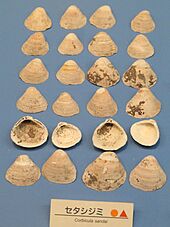
The oldest signs of people living in Osaka are the Morinomiya ruins (森ノ宮遺跡, Morinomiya iseki). Here, scientists found human skeletons and shell mounds. They also found tools like arrowheads and fishing hooks. These findings show that people lived here over 2,000 years ago.
Later, during the Yayoi period (300 BCE-250 CE), rice farming became popular. More people started living permanently on the plains. Around 200 CE, the important Sumiyoshi-taisha shrine was built near the harbor. This shrine started a new style of building for Shinto shrines.
Osaka in the Kofun Period
By the Kofun period (around 300-538 AD), Osaka became a major port. It connected Japan to other parts of Asia. Trade grew a lot. Large burial mounds called Kofun were built in Osaka. These show that powerful leaders lived here. Some of these mounds can still be seen today.
Important projects happened during this time. A river was redirected to stop floods. New roads were built to connect Osaka to other cities. The port of Naniwa-tsu became very busy. Huge warehouses were built to store goods.
Imperial Capital: Asuka and Nara Periods
In 645, Emperor Kōtoku built his palace in Osaka. This made Osaka, then called Naniwa, the capital of Japan. Even though the capital moved later, Naniwa stayed an important link. It connected Japan to Korea and China by land and sea.
Naniwa was again the capital for a short time in 744. By the end of the Nara period, other ports took over some of Naniwa's roles. But it remained a busy center for travel and trade. The Shitennō-ji temple, one of Japan's oldest Buddhist temples, was first built in 593 CE.
- Gallery
From Heian to Edo: Merchants and Culture
In 1496, a Buddhist group built a strong temple called Ishiyama Hongan-ji. It was on the site of the old Naniwa Imperial Palace. Later, Oda Nobunaga attacked this temple for ten years. After the monks surrendered, the temple was destroyed.
In 1583, Toyotomi Hideyoshi built Osaka Castle in its place. This castle was very important in the Siege of Osaka (1614–1615).
Osaka was known as Japan's main economic center for a long time. Many people belonged to the merchant class. During the Edo period (1603–1867), Osaka grew into a big city again. It became a lively and important port.
Merchants in Osaka created a system to store rice for feudal lords. They would trade this rice for money or receipts. This was like an early form of paper money. The Dōjima Rice Exchange was set up in 1697. It became the world's first futures market for rice.
Osaka also had a lively arts scene. Famous Kabuki and Bunraku theaters were popular. In 1837, a low-ranking samurai named Ōshio Heihachirō led a peasant uprising. He was upset that the city wasn't helping poor families. The rebellion was stopped, but about a quarter of the city was destroyed.
Osaka was opened to foreign trade in 1868. This happened just before the Meiji Restoration. People from Edo (now Tokyo) sometimes made fun of Osakans. They called them stingy and too focused on food. Even today, some people in Tokyo joke about Osakans loving food so much they "eat until they collapse."
- Gallery
-
Osaka Castle (first built in 1583)
-
Japanese painting of the Siege of Osaka (1615)
Modern Osaka: Meiji to Today
After the Meiji Restoration in 1868, Japan changed a lot. The capital moved from Kyoto to Tokyo. Osaka became more of an industrial center. The modern city of Osaka was officially created in 1889. It was much smaller then.
Osaka grew quickly and became known as the "Manchester of the Orient." By 1925, it was the largest city in Japan. It was also the sixth-largest city in the world. Many immigrants from Asia came to Osaka for work.
During World War II, Osaka was bombed in 1945. Large parts of the city were destroyed. But after the war, Osaka rebuilt quickly. Its population grew again. The city became a major multicultural and financial center. It was called the "Chicago of the Orient."
Osaka hosted Expo '70, the first world's fair in Asia. Since then, many international events have taken place here. In 1956, Osaka became one of the first cities in Japan to be a "designated city." This means it has more power over its own affairs.
In recent years, there have been discussions about changing Osaka's government. There were ideas to make it more like Tokyo. But these plans were voted down by the people of Osaka.
Osaka has been ranked as one of the most expensive cities in the world. In 2009, it was the second most expensive after Tokyo. But by 2020, it had dropped to fifth place. In 2014, the Abeno Harukas skyscraper opened. It was the tallest building in Japan for a while.
- Gallery
Where is Osaka Located?
Osaka is on the western side of Japan. It faces Osaka Bay. The city is surrounded by many other smaller cities. Most of these are in Osaka Prefecture. The city itself covers about 13% of the prefecture's total area.
Osaka's highest point is 37.5 meters (123 feet) above sea level. Its lowest point is 2.2 meters (7.2 feet) below sea level. Osaka is located at a latitude of 34.67 degrees North. This means it is further south than cities like Rome or San Francisco.
Osaka's Climate and Weather
Osaka has a humid subtropical climate. This means it has four clear seasons. Winters are usually mild. Snowfall is rare. Spring starts mild but becomes hot and humid. It's also the wettest season. The rainy season, called tsuyu, is from early June to late July.
Summers are very hot and humid. August is the hottest month. The average high temperature is about 33.7°C (92.7°F). Nighttime lows are around 25.8°C (78.4°F). Fall brings cooler weather. There is a second rainy period in September and early October. This is when typhoons can happen.
Exploring Osaka's Neighborhoods
Osaka's city area is split into two main parts: Kita (north) and Minami (south).
Kita: The Northern Hub
Kita is home to the Umeda district. This is a big area for business and shopping. It has Osaka Station City and many underground shopping areas. Kita and nearby Nakanoshima have most of the city's tall skyscrapers.
Minami: The Southern Center
Minami means "south," but it's actually in the central part of the city. Here you'll find popular shopping areas like Namba and Shinsaibashi. Dōtonbori is a famous entertainment area with a canal. Nipponbashi Den Den Town is known for electronics and anime. Amerikamura and Horie are trendy areas for arts and fashion. The Abeno Harukas is also in this area.
Semba: The Business Heart
Between Kita and Minami are business districts like Honmachi and Yodoyabashi. This area is called Semba. Many large banks and companies have their main offices here. The Midōsuji boulevard runs through Semba, connecting Kita and Minami.
Other Interesting Areas
South of Minami are neighborhoods like Shinsekai, with its Tsūtenkaku tower. Tennoji and Abeno have Tennoji Zoo and Shitennō-ji.
The west side of the city is the bay area. It's the main port and a tourist spot. You can find Kyocera Dome and Universal Studios Japan here. The east side of Osaka has many homes. It also has Osaka Castle Park and Osaka Business Park.
Osaka has many canals and bridges. In the past, people used to say "808 bridges of Naniwa." This meant there were countless bridges. Today, Osaka City manages 760 bridges.
- Gallery
Osaka's Wards
Osaka is divided into 24 smaller areas called wards. Each ward has its own local government.
| Name | Kanji | Population | Land area in km2 | Pop. density
per km2 |
Map of Osaka | |
|---|---|---|---|---|---|---|
| 1 | Abeno-ku | 阿倍野区 | 107,000 | 5.99 | 18,440 | |
| 2 | Asahi-ku | 旭区 | 90,854 | 6.32 | 14,376 | |
| 3 | Chūō-ku | 中央区 | 100,998 | 8.87 | 11,386 | |
| 4 | Fukushima-ku | 福島区 | 78,348 | 4.67 | 16,777 | |
| 5 | Higashinari-ku | 東成区 | 83,684 | 4.54 | 18,433 | |
| 6 | Higashisumiyoshi-ku | 東住吉区 | 126,704 | 9.75 | 12,995 | |
| 7 | Higashiyodogawa-ku | 東淀川区 | 176,943 | 13.27 | 13,334 | |
| 8 | Hirano-ku | 平野区 | 193,282 | 15.28 | 12,649 | |
| 9 | Ikuno-ku | 生野区 | 129,641 | 8.37 | 15,489 | |
| 10 | Jōtō-ku | 城東区 | 167,925 | 8.38 | 20,039 | |
| 11 | Kita-ku (administrative center) | 北区 | 136,602 | 10.34 | 13,211 | |
| 12 | Konohana-ku | 此花区 | 65,086 | 19.25 | 3,381 | |
| 13 | Minato-ku | 港区 | 80,759 | 7.86 | 10,275 | |
| 14 | Miyakojima-ku | 都島区 | 107,555 | 6.08 | 17,690 | |
| 15 | Naniwa-ku | 浪速区 | 74,992 | 4.39 | 17,082 | |
| 16 | Nishi-ku | 西区 | 103,089 | 5.21 | 19,787 | |
| 17 | Nishinari-ku | 西成区 | 108,654 | 7.37 | 14,743 | |
| 18 | Nishiyodogawa-ku | 西淀川区 | 95,960 | 14.22 | 6,748 | |
| 19 | Suminoe-ku | 住之江区 | 120,629 | 20.61 | 5,853 | |
| 20 | Sumiyoshi-ku | 住吉区 | 153,425 | 9.40 | 16,322 | |
| 21 | Taishō-ku | 大正区 | 62,872 | 9.43 | 6,667 | |
| 22 | Tennōji-ku | 天王寺区 | 80,830 | 4.84 | 16,700 | |
| 23 | Tsurumi-ku | 鶴見区 | 111,501 | 8.17 | 13,648 | |
| 24 | Yodogawa-ku | 淀川区 | 182,254 | 12.64 | 14,419 |
People of Osaka
Osaka has been recording its population since 1873. In 2005, there were about 2.6 million people living in Osaka. The population density was very high, with over 11,800 people per square kilometer.
After a big earthquake in 1923, many people moved to Osaka. In 1930, Osaka became Japan's largest city. It had more people than Tokyo. The population reached its highest point in 1940. After World War II, it grew again. But since the 1960s, many people have moved to the suburbs.
Osaka has many foreign residents. The largest groups are from Korea and China. The Ikuno ward has one of the biggest Korean communities in Japan.
Osaka's Unique Dialect
People in Osaka speak a special dialect called Osaka-ben. It's a type of Kansai-ben. For example, they often use ya instead of da for "is." They also use -hen instead of -nai for negative verbs.
Osaka's Economy
Osaka has always been a major center for business in Japan. It was especially important in older times. Today, it is still a very important part of Japan's economy.
In 2004, Osaka's total economic output was about ¥21.3 trillion. This was about 55% of the total for Osaka Prefecture. The main industries are commerce (buying and selling goods), services, and manufacturing.
Many big companies have their headquarters in Osaka. These include Panasonic and Sharp. Osaka also has an important stock exchange. It specializes in futures trading. The city is working to attract more businesses and investments.
Osaka is part of a large metropolitan area called Keihanshin. This area also includes Kyoto and Kobe. The Keihanshin region has a population of over 19 million people. It is the second-largest urban area in Japan. It also has a very high economic output.
Getting Around Osaka
Greater Osaka has a huge network of train lines. It's similar to Tokyo's train system. Major train stations in Osaka include Umeda, Namba, and Tennoji.
The Osaka Metro system is very busy. It serves over 912 million people each year. This is a quarter of all riders on the Greater Osaka train system.
All Shinkansen (bullet trains) stop at Shin-Osaka Station. From here, you can travel to other big cities like Kobe, Kyoto, Nagoya, and Tokyo.
Osaka also has a good bus system. It covers most parts of the city.
There are two airports near Osaka. Kansai International Airport (KIX) handles most international flights. Osaka International Airport (ITM) is mainly for flights within Japan.
Osaka also has many international ferry connections. You can take a ferry to cities like Shanghai, Tianjin, and Busan.
Culture and Fun in Osaka

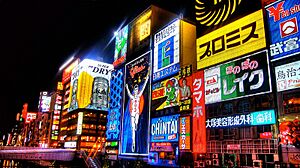
Shopping and Delicious Food
Osaka has many shops. There are malls and traditional shopping arcades called shōtengai. Osaka has the longest shōtengai in Japan. It's called the Tenjinbashi-suji arcade. It stretches for 2.6 kilometers (1.6 miles).
Other shopping areas include Den Den Town. This area is known for electronics, manga, and anime. The Umeda district has big shopping malls and department stores.
Osaka is famous for its food. Some people even call it the food capital of the world! There's an old saying in Osaka: "Kyotoites are financially ruined by overspending on clothing, Osakans are ruined by spending on food."
Popular local dishes include okonomiyaki (a savory pancake) and takoyaki (fried octopus balls). You can also try udon noodles and oshizushi (pressed sushi). Osaka is also known for its excellent sake.
Entertainment and Arts
Osaka has many places for entertainment.
- The National Bunraku Theatre shows traditional puppet plays.
- You can watch kabuki plays at Osaka Shochiku-za.
- The Namba Grand Kagetsu hall has comedy shows.
- The Hanjō-tei theater is for rakugo (storytelling).
- The Umeda Arts Theater hosts musicals, concerts, and dramas.
- The Symphony Hall is specially designed for classical music.
- Osaka-jō Hall is a large arena for concerts and events.
- The Osaka Shiki Theater stages plays and musicals.
Fun Festivals
Osaka has many exciting festivals throughout the year.
- The Tenjin Matsuri is one of the most famous. It happens on July 24 and 25.
- Other festivals include the Aizen Matsuri and the Sumiyoshi Matsuri.
- The annual Osaka Asian Film Festival takes place every March.
Museums and Galleries
Osaka has many interesting museums.
- The National Museum of Art shows Japanese and international art.
- The Osaka Science Museum has a planetarium and an OMNIMAX theater.
- The Museum of Oriental Ceramics has over 2,000 pieces of pottery.
- The Osaka Municipal Museum of Art has Japanese and Chinese paintings.
- The Osaka Museum of History tells the story of Osaka from ancient times to today.
Sports in Osaka
Osaka is home to several professional sports teams.
- The Orix Buffaloes are a baseball team. They play at Kyocera Dome Osaka.
- Another baseball team, the Hanshin Tigers, also plays some games here.
- There are two J.League soccer clubs: Gamba Osaka and Cerezo Osaka.
- The Osaka Evessa is a basketball team.
- The Kintetsu Liners are a rugby union team.
One of the six major professional sumo tournaments, the Haru Basho (Spring Tournament), is held in Osaka every year.
Osaka also hosts the Osaka International Ladies Marathon. This race starts and ends at Nagai Stadium. The Osaka Gran Prix Athletics games are also held here. Osaka tried to host the 2008 Summer Olympics, but Beijing was chosen instead.
Education in Osaka
The city of Osaka runs public elementary and junior high schools. Public high schools are run by the Osaka Prefectural Board of Education.
Many universities and high schools in Osaka have moved to the suburbs. This is because they needed more space. One example is Osaka University.
Some of the colleges and universities in Osaka include:
- Kansai University
- Osaka Metropolitan University
- Osaka University of Economics
- Osaka Institute of Technology
Osaka also has several libraries. These include the Osaka Municipal Central Library and the Osaka Prefectural Nakanoshima Library.
Places to Visit in Osaka
Fun Places and Tall Buildings
Osaka has many exciting places and impressive buildings.
- Universal Studios Japan is a popular theme park.
- Abeno Harukas is a very tall skyscraper.
- Tsūtenkaku is a famous tower.
- Umeda Sky Building offers great views.
- Namba Parks is a unique shopping and entertainment complex.
Historical Sites
You can explore Osaka's past at these sites:
- Osaka Castle is a famous landmark.
- The Kawaguchi foreign settlement shows where foreigners lived in the past.
- The Ruins of Naniwanomiya Palace are the remains of an ancient imperial palace.
Parks and Gardens
Osaka has many beautiful green spaces.
- Utsubo Park is known for its rose garden.
- Nakanoshima Park is located on an island between rivers.
- Osaka Castle Park surrounds the famous castle.
- Tennoji Park is a large park with a zoo.
- Nagai Park is home to sports venues.
- Gallery
Important Buildings
Osaka has many examples of old and new architecture.
- Sumiyoshi Taisha main shrine is a national treasure.
- The Osaka City Central Public Hall is a beautiful old building.
- The Osaka Prefectural Nakanoshima Library is also a historic building.
- The Osaka Securities Exchange building is a modern landmark.
Theaters and Performance Halls
- National Bunraku Theatre
- Umeda Arts Theater
- Osaka-jō Hall
- The Symphony Hall
- Festival Hall, Osaka
Sports Venues
- Kyocera Dome Osaka (baseball)
- Yanmar Stadium Nagai (soccer)
- Nagai Park (various sports facilities)
Religious Sites
Osaka has many shrines and temples.
- Sumiyoshi Taisha (Shinto shrine)
- Osaka Tenmangu (Shinto shrine)
- Shitennō-ji (Buddhist temple)
- Isshin-ji (Buddhist temple)
Osaka's Global Connections
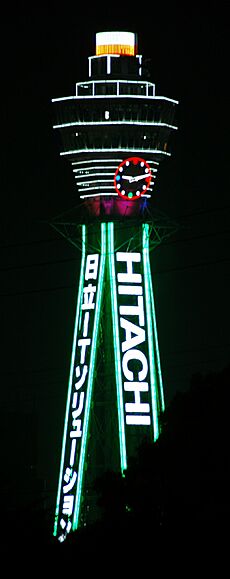
Osaka has many connections with cities around the world.
Sister Cities
Osaka is twinned with several cities, meaning they have special friendly relationships:
- Chicago, United States
- Hamburg, Germany
- Lyon, France
- Melbourne, Australia
- Milan, Italy
- Saint Petersburg, Russia
- São Paulo, Brazil
- Shanghai, China
- Toronto, Canada
Friendship Cities
Osaka also cooperates with other cities:
- Budapest, Hungary
- Busan, South Korea
- Buenos Aires, Argentina
- Dnipro, Ukraine
- Seattle, United States
Business Partner Cities
Osaka has business partnerships with many cities, especially in Asia:
- Auckland, New Zealand
- Bangkok, Thailand
- Brisbane, Australia
- Ho Chi Minh City, Vietnam
- Hong Kong, China
- Jakarta, Indonesia
- Kuala Lumpur, Malaysia
- Los Angeles, United States
- Manila, Philippines
- Mumbai, India
- Seoul, South Korea
- Singapore
- Tianjin, China
Sister Ports
Osaka's port also has special relationships with other ports:
- Port of Busan, South Korea
- Port of Le Havre, France
- Port of Melbourne, Australia
- Saigon Port, Vietnam
- Port of San Francisco, United States
- Port of Shanghai, China
- Port of Valencia, Spain
- Port of Valparaiso, Chile
See also
 In Spanish: Osaka para niños
In Spanish: Osaka para niños












